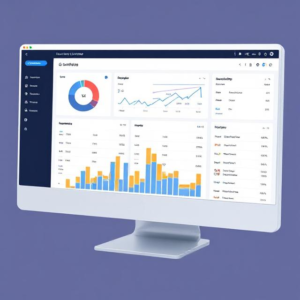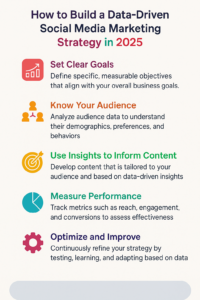In today’s hyper-digital world, leveraging data to inform your social media marketing strategy is no longer optional—it’s essential. Data empowers you to make informed decisions, improve audience engagement, and maximize ROI.
In this blog, we’ll guide you through the process of crafting a data-driven social media marketing strategy tailored for success in 2025.
📊 1. Define Clear Goals and KPIs
Before diving into the numbers, start by setting clear objectives for your social media campaigns. Align your goals with broader business objectives, whether it’s to boost brand awareness, drive website traffic, or increase sales.
Key Metrics to Track:
- Reach and impressions for brand awareness
- Click-through rates (CTR) and conversions for website traffic
- Engagement rates (likes, shares, comments) for audience interaction
| Feature / Tool | Primary Focus | Key Metrics | Audience Insights |
| Google Analytics | Website & app user behaviour | Users, sessions, conversions, bounce rate | Demographics, interests, behaviour |
| Hootsuite Insights | Social media engagement & performance | Views, engagement, clicks, sentiment | Social listening, mentions, hashtags |
| Meta Business Suite | Facebook & Instagram management | Reach, engagement, clicks, ad spend | Demographics, engagement patterns |
Action Tip:
Use tools like Google Analytics, Hootsuite Insights, or Meta Business Suite to track these metrics effectively.
🔬 2. Understand Your Audience

A deep understanding of your target audience is crucial. Leverage data analytics to identify your audience’s demographics, preferences, and behaviours.
Tools like Facebook Audience Insights or Instagram Analytics can provide valuable insights into:
- Age, gender, and location
- Preferred content formats (e.g., videos, images, or stories)
- Active times on platforms
Action Tip:
Create detailed audience personas to tailor your content and campaigns effectively.
| Persona Data Point | Facebook Audience Insights |
| Age & Gender | Age & gender breakdown |
| Location | Top cities & countries |
| Content Preferences | Top posts & video types |
| Active Times | Audience peak hours |
| Interests | Pages liked & interests |
| Segmentation | Custom & lookalike audiences |
| Purchase Behaviour | Purchase patterns (aggregate) |
🔀 3. Analyze Competitor Performance

Keeping an eye on competitors can reveal valuable insights about what works (and what doesn’t). Study their top-performing posts, engagement rates, and hashtags.
Steps to Follow:
- Identify your top competitors on platforms like Instagram, LinkedIn, or TikTok.
- Use tools like Sprout Social or SEMrush Social Media Tracker to analyze their performance.
- Identify gaps and opportunities in their strategies.
| Spects | Steps to Follow | Outcome |
| Competitor Identification | 1. List top competitors on Instagram, LinkedIn, TikTok, etc. | A defined list of competitors to analyze. |
| Performance Metrics | 2. Use analytical tools to gather data on competitors’ performance. | A dataset of competitor performance metrics. |
| Content Analysis | 3. Identify patterns in post themes, visuals, and captions. | Insights into effective content strategies. |
| Hashtag Research | 4. Compile a list of commonly used hashtags from competitors’ posts. | A list of hashtags with high engagement potential. |
| Engagement Analysis | 5. Compare engagement rates across posts and platforms. | Data on what drives audience engagement. |
| Gap Identification | 6. Look for inconsistencies, underutilized platforms, or gaps in content. | Opportunities for differentiation and improvement. |
| Strategic Planning | 7. Integrate findings into your content calendar and strategy plan. | A data-driven strategy tailored to your audience’s needs. |
🔶 4. Create Data-Driven Content

Content remains king, but its effectiveness hinges on data. Use past performance metrics to guide your content creation process.
Types of Data to Analyze:
- Post engagement rates: Identify the type of content your audience interacts with most.
- Timing insights: Determine the best times to post for maximum reach.
- Hashtag performance: Track which hashtags drive the most impressions.
| Goal | Key Metrics to Track | Example Tools |
| Brand Awareness | Reach, Impressions | Meta Business Suite, Sprinklr |
| Engagement | Likes, Shares, Comments, Saves | Hootsuite Insights, Buffer |
| Website Traffic | Click-Through Rate (CTR), Bounce Rate | Google Analytics, SEMrush |
| Lead Generation | Conversion Rates, Cost Per Lead (CPL) | HubSpot, Marketo |
Action Tip:
Experiment with different content types (e.g., videos, carousel posts, and polls) and monitor performance to refine your approach.
🔍 5. Leverage AI and Automation

AI-driven tools can simplify your data analysis and help you optimize your strategy in real-time.
Top Tools for 2025:
- ChatGPT or Jasper: For generating content ideas and captions
- Buffer or Later: For scheduling posts based on data-driven insights
- Sprinklr: For comprehensive analytics and social listening
Action Tip:
Integrate AI tools to automate repetitive tasks and focus on strategy and creativity.
| Content Format | Ideal Use Case | Benefits |
| Short-Form Video | Announcements, Quick Tips | High Engagement, Viral Potential |
| Carousel Posts | Tutorials, Multi-Step Guides | Increased Saves, In-Depth Info |
| Polls and Surveys | Audience Feedback, Market Research | High Interaction, Insights |
| Stories | Timely Updates, Behind-the-Scenes Content | Authenticity, FOMO Effect |
🌐 6. Monitor and Optimize Regularly

Social media trends and algorithms evolve rapidly. To stay ahead, make continuous optimization a core part of your strategy.
Steps for Ongoing Optimization:
- Review weekly analytics to identify underperforming posts.
- A/B test different content formats and messaging.
- Adjust your strategy based on new data and trends.
Action Tip:
Schedule monthly strategy reviews with your team to discuss insights and implement changes.
🏆 Conclusion: Data Is Your Superpower
Building a data-driven social media strategy in 2025 requires more than just intuition; it demands a systematic approach backed by analytics.
By defining clear goals, understanding your audience, analyzing competitors, creating data-driven content, leveraging AI, and optimizing regularly, you can stay ahead of the curve and achieve your business objectives.
Start incorporating these steps today and watch your social media efforts transform into a powerhouse of engagement and ROI.
Infographics for quick recap:


